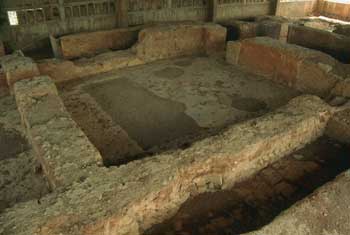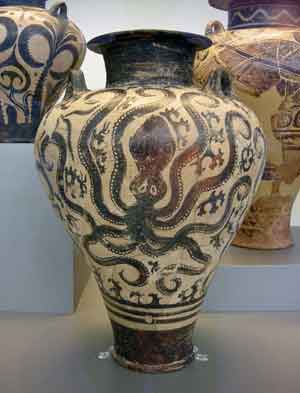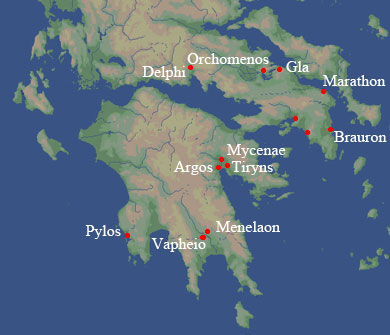
The Rise of Aegean Civilization
Agriculture had been the mainstay of life in the Aegean world from a very early point. Typical farming villages were well-established in Thessaly and Crete by around 6500 BC. The occupants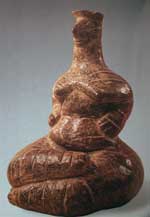 grew wheat and barley and tended a variety of livestock, including cattle, sheep, goats and pigs. By the fifth millennium BC, some quite substantial settlements could be found on the mainland. Some of these, such as Sesklo in Thessaly, were enclosed by walls and had substantial stone architecture. This, along with evidence of specialized craft production, suggests an organized society with some sort of hierarchy.
grew wheat and barley and tended a variety of livestock, including cattle, sheep, goats and pigs. By the fifth millennium BC, some quite substantial settlements could be found on the mainland. Some of these, such as Sesklo in Thessaly, were enclosed by walls and had substantial stone architecture. This, along with evidence of specialized craft production, suggests an organized society with some sort of hierarchy.
By the middle part of the fourth millennium BC, metal objects begin to a appear in the archaeological record—tools such as hooks, pins and flat axes but also some objects of silver and gold have turned up in tomb deposits. Within a thousand years, bronze using societies were firmly established on the mainland as well as in the Cycladic Islands. The metal objects now included cast bronze axes, adzes and short daggers—the latter probably as much display items as weapons—which bear a close resemblance to types found in contemporary Anatolia (modern Turkey). Many scholars believe that they were introduced by immigrants from that region but, since the Aegean is generally poorly provided with sources of copper and tin, ‘trade’ may be a simpler explanation.
As well as the appearance of new types of metalwork, there was another important development taking place in the field of agriculture at the same time. A number of new crops were introduced, including olives and grapes, which were used to produce oil and wine. They enabled the farmer to make better use of hillsides and stony ground not suited to the plough. However, the new crops required a heavy initial investment of labour and time before they became productive. Only those with a certain amount of ‘wealth’ could afford to take the long-term view. One significant advantage that oil and wine had is that they were relatively easy to store and transport compared  to grain—an important consideration if you are keen to get your hands on exotic metalwork.
to grain—an important consideration if you are keen to get your hands on exotic metalwork.
Similar changes were occurring in the animal husbandry. Cattle were now bred to pull the plough, enabling the farmer to bring more marginal land under cultivation. Sheep were now raised for their wool, which was used to weave textiles—another commodity that could be stored and shipped with relative ease. All of this suggests the emergence of a stratified society with leadership positions and economic wealth concentrated into the hands of a few individuals, a fact supported by the evidence from burials where there are pronounced differences in status.
During the third millennium BC, fortified strongholds—a sure indication of the presence of powerful political leaders—appear in the Cyclades as well as on the mainland. One such is the site of Lerna (left), which lies only a few kilometres from Mycenae itself. The site had casemate walls (a thick wall with a number of chambers within) with projecting bastions and contained a large megaron style building known as the House of Tiles. A megaron is a rectangular building with a porch at one end and was the basis of much of Greek architecture in antiquity. It was the basic form of the Late Bronze Age palace as well as the Classical temple. Greece was now under the control of powerful rulers who controlled a substantial surplus of wealth and were anxious to place a larger role on the world stage.
The Late Bronze Age
Palaces first appear on the Greek mainland towards the end of the Bronze Age, say about 1400 BC, with the phenomenon lasting until about 1200 BC. This is the period conventionally known as Late Helladic IIIA-IIIB— principally based on the styles of pottery in use at the time. It was generally a prosperous period, dominated by powerful kingdoms and empires— Egypt, Mesopotamia and the Hittites in their Anatolian stronghold. But it was a highly competitive period as well, with the various great powers fighting to impose their dominance in the region and to control the trade routes along which flowed the goods they all prized. Everything linked up in the coastal strip which ran along the eastern end of the Mediterranean, from Egypt to Anatolia, known as the Levant. The Incense Road from Yemen ran through here and the Silk Road out of Central Asia ended here. Trading ships from the Levant plied the waters of the Eastern Mediterranean, exchanging luxury  manufactures and exotic goods for the products of North Africa, the Aegean and beyond.
manufactures and exotic goods for the products of North Africa, the Aegean and beyond.
The Mycenaean Greeks were very much involved in all of this activity and their highly distinctive pottery has been found very widely distributed throughout the region. Some idea of the goods involved is known from the cargo of a Canaanite merchant ship recovered from the bottom of the sea (left) near Ulu Burun on the southern coast of Turkey. It was carrying pottery from Cyprus, Greece and the Levant containing olives, grain wine and terebinth resin (used in making perfume). Ingots of tin from Anatolia, copper from Cyprus and glass from Syria were found along with various items of bronze, faience objects and jewellery. It would seem that the main exports of the Greeks were agricultural— wine, olive oil and woollens.
The Greeks were apparently one of the major players of the day. We have letters, found in the Hittite royal archives at Hattušaš, addressed to the king of the land of Ahhiyawa and calling him “brother” and putting him on a par with the kings of Babylon and the pharaoh of Egypt. It seems pretty clear that Ahhiyawa refers to Achaea, the Homeric term for Greece— although the idea of a unified kingdom does not entirely square with Homer’s description of Mycenaean society nor with the evidence produced by archaeology. Both of these sources suggest a fragmented society, dominated by highly competitive warlords.

Map of the Near East in the Late Bronze Age
In many aspects of its material culture at least, the Mycenaeans owed an enormous debt to the Minoan civilization of Crete which had dominated the Aegean world for much of the second millennium BC. At some point in the fifteenth century BC, Mycenaean Greeks from the Mainland appear to have conquered Crete. The Cretan palaces were all destroyed, save only the one at Knossos which was maintained by the new rulers. However, the design of Mainland palaces owed little (if anything) to those found in Crete and appear to have served a somewhat different function.
The Rise of Palaces
No building which can be confidently identified as a palace has survived any earlier than Late Helladic III, although part of a large Late Helladic I building, including a courtyard, was uncovered at Peristeria in the south-western Peloponnese and traces of earlier walls have been found underlying the later buildings at Mycenae and Tiryns in the Argolid. The earliest definite remains 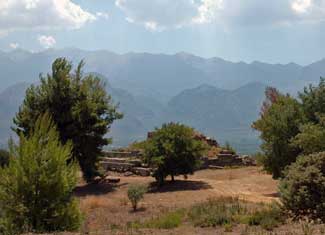 of a palatial building, dating to near the end of the LHIIIA period, were uncovered near the Menelaion (left) near Sparta in the Peloponnese. The site had been occupied for several centuries at this point (some badly eroded Middle Helladic walls were found). But the only suggestion of any earlier large-scale construction was the fact that some re-used stone blocks were used to construct the latest building. That structure was based, like all subsequent palaces, on the megaron plan. A megaron is essentially an rectangular building with projecting walls forming a porch at one end, such as the central element of the Menalaion. This basic single-roomed plan could be and generally was elaborated by the addition of other rooms. At the Menelaion, long corridors ran down either side of the central megaron separating it from rows of storage rooms and possibly a stairway to an upper storey.
of a palatial building, dating to near the end of the LHIIIA period, were uncovered near the Menelaion (left) near Sparta in the Peloponnese. The site had been occupied for several centuries at this point (some badly eroded Middle Helladic walls were found). But the only suggestion of any earlier large-scale construction was the fact that some re-used stone blocks were used to construct the latest building. That structure was based, like all subsequent palaces, on the megaron plan. A megaron is essentially an rectangular building with projecting walls forming a porch at one end, such as the central element of the Menalaion. This basic single-roomed plan could be and generally was elaborated by the addition of other rooms. At the Menelaion, long corridors ran down either side of the central megaron separating it from rows of storage rooms and possibly a stairway to an upper storey.
The evidence of the Shaft Graves (see below) at Mycenae testify to an enormous concentration of wealth and power into the hands of a very few people during the sixteenth and fifteenth centuries BC. Palaces, with their extensive storage facilities and associated workshops, are clearly the seats of power of this elite. Insofar as can be determined by the surviving palaces, they are generally secular in character, unlike Crete where religious practices seem most important. As is the case on Crete, purely domestic and residential suites cannot be identified— presumably they were located on the upper floors and hence did not survive.
The Palace System
Homer’s description of Achaean society seems to be reflected in the number and distribution of palaces throughout the Greek Mainland. The remains of palaces have been found at Mycenae, Tiryns, Thebes, Pylos and Athens. The presence of monumental tombs known as tholoi suggest 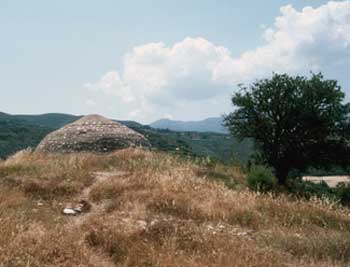 that other centres of wealth and power were located at Amyklae in Laconia; at Eleusis, Marathon and Brauron in Attica; at Peristeria (left) in the Peloponnese, and at Delphi and Orchomenos in Central Greece. Remains of palatial buildings are currently being excavated at the site of Iolkos in Thessaly. The presence of so many centres in such a warlike society would seem to indicate political fragmentation— at best a some sort of loose confederation under the hegemony of one of a number of kings. Even with a relatively small area, such as the Argolid or Attica, there appear to have been a number of important centres. The nature of the relationship between Mycenae, Tiryns, Argos, Midea and Asine in the former region is unclear— were they allies or were the smaller centres all under the dominance of Mycenae? It is difficult to imagine the circumstances under which the latter would tolerate the existence of the massive fortress at Tiryns, only a few kilometres away unless it was somehow under its control.
that other centres of wealth and power were located at Amyklae in Laconia; at Eleusis, Marathon and Brauron in Attica; at Peristeria (left) in the Peloponnese, and at Delphi and Orchomenos in Central Greece. Remains of palatial buildings are currently being excavated at the site of Iolkos in Thessaly. The presence of so many centres in such a warlike society would seem to indicate political fragmentation— at best a some sort of loose confederation under the hegemony of one of a number of kings. Even with a relatively small area, such as the Argolid or Attica, there appear to have been a number of important centres. The nature of the relationship between Mycenae, Tiryns, Argos, Midea and Asine in the former region is unclear— were they allies or were the smaller centres all under the dominance of Mycenae? It is difficult to imagine the circumstances under which the latter would tolerate the existence of the massive fortress at Tiryns, only a few kilometres away unless it was somehow under its control.
Fortified citadels are characteristic of the LHIII Period and all of the major excavated palaces seem to have them, with the conspicuous exception of Pylos. At Mycenae the earliest phase of Cyclopean Walls were erected in the 14th century BC—LHIIIA potsherds were found sealed beneath the north wall. In the absence of any external threats at this early date, they should probably be seen as reflecting internal conflict within the Mycenaean world. Their destruction, when it does come in the late 13th or early 12 century BC, seems to be the result of civil wars rather than invasion. According to the Classical tradition, the various Mycenaean states were almost constantly at war with one another. Two separate wars were fought against Thebes— the legend of the ‘Seven Against Thebes’ which failed to capture the city and the attack of the Epigoni, a generation later, which ended in its destruction.

